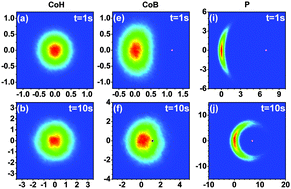Effects of translation–rotation coupling on the displacement probability distribution functions of boomerang colloidal particles
Abstract
Prior studies have shown that low symmetry particles such as micro-boomerangs exhibit behaviour of Brownian motion rather different from that of high symmetry particles because convenient tracking points (TPs) are usually inconsistent with their center of hydrodynamic stress (CoH) where the translational and rotational motions are decoupled. In this paper we study the effects of the translation–rotation coupling on the displacement probability distribution functions (PDFs) of the boomerang colloid particles with symmetric arm length. By tracking the motions of different points on the particle symmetry axis, we show that as the distance between the TP and the CoH is increased, the effects of translation–rotation coupling becomes pronounced, making the short-time 2D PDF for fixed initial orientation to change from elliptical, to bean and then to crescent shape, and the angle averaged PDFs change from ellipsoidal-particle-like PDF to a shape with a Gaussian top and long displacement tails. We also observed that at long times the PDFs revert to Gaussian. These 2D PDF shapes provide a clear physical picture of the non-zero mean displacements observed in boomerangs particles.


 Please wait while we load your content...
Please wait while we load your content...